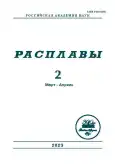CALCULATION OF THE MELTING POINTS OF ALKALI HALIDES USING THE THERMODYNAMIC PERTURBATION THEORY
- Authors: Davydov A.G.1, Tkachev N.K.1
-
Affiliations:
- Institute of High Temperature Electrochemistry of the UB RAS
- Issue: No 2 (2023)
- Pages: 167-181
- Section: Articles
- URL: https://bakhtiniada.ru/0235-0106/article/view/138586
- DOI: https://doi.org/10.31857/S0235010623020032
- EDN: https://elibrary.ru/MHTDUB
- ID: 138586
Cite item
Full Text
Abstract
A model for calculating phase equilibria between a liquid and a crystal is proposed, which makes it possible to evaluate the melting points of ionic compounds. The dependence of the melting temperatures of alkali halides on the cation-anion composition can be described in terms of ionic radii and polarizabilities using thermodynamic perturbation theory for the molten phase. The chemical potential of the crystal phase contains the Born-Mayer formula for the electrostatic part of the energy and the Debye formula for the vibration contribution. The full system of equations describing the equilibrium between liquid and solid includes not only the equality of chemical potentials, but also contains the equation of state to calculate the equilibrium density of melts at the crystallization point. One more equation of the system is necessary for the self-consistent computation of the characteristic Blum’s screening parameter within the mean spherical model of the ionic mixture. On this basis, the melting points of fluorides, chlorides, bromides and iodides of lithium, sodium, potassium, rubidium and cesium have been calculated. It has been shown that the combination of the reference mean-spherical model of charged hard spheres with different diameters and the perturbation due to the charge-induced dipoles into the chemical potentials of molten salts is a good basis for quantitative agreement with experimental data on the melting temperatures within a few percent. Moreover, the regularities of the change in the melting temperatures reduced to the Coulomb energy at the maximum contact of the cation and anion, as well as depending on the difference in the ionic radii of the salts, are discussed.
About the authors
A. G. Davydov
Institute of High Temperature Electrochemistry of the UB RAS
Author for correspondence.
Email: A.Davydov@ihte.uran.ru
Russia, Yekaterinburg
N. K. Tkachev
Institute of High Temperature Electrochemistry of the UB RAS
Email: A.Davydov@ihte.uran.ru
Russia, Yekaterinburg
References
- Haynes W.M. Handbook of chemistry and physics: 97th Edition. CRC Press: Taylor & Francis Group, 2017.
- Pauling L. The nature of the chemical bond: 3th Edition. Cornell University Press, 1960.
- Dworkin A.S., Bredig M.A. // J. Phys. Chem. 1960. 64. P. 269–272. https://doi.org/10.1021/j100831a023
- Forland T. Thermodynamic properties of fused salt systems. In: Fused salts. Sundheim B.R., Ed., McGraw-Hill. 1964. P. 63–164.
- Kanno H. // Nature. 1968. 218. P. 765–766. https://doi.org/10.1038/218765b0
- Kanno H. // Bull. Chem. Soc. Jpn. 1977. 50. P. 2799–2800. https://doi.org/10.1246/bcsj.50.2799
- Aragones J.L., Sanz E., Valeriani C., Vega C. // J. Chem. Phys. 2012. 137. P. 104507. https://doi.org/10.1063/1.4745205
- Sun X.W., Chu Y.D., Liu Z.J., Kong B. et al. // Phys. B: Condens. Matter. 2012. 407. P. 60–63. https://doi.org/10.1016/j.physb.2011.09.119
- DeFever R.S., Wang H., Zhang Y., Maginn E.J. // J. Chem. Phys. 2020. 153. P. 011101. https://doi.org/10.1063/5.0012253
- Madden P.A., Wilson M. // Chem. Soc. Rev. 1996. 25. P. 339–350. https://doi.org/10.1039/cs9962500339
- Salanne M., Simon C., Turq P., Madden P.A. // J. Fluor. Chem. 2009. 130. P. 38–44. https://doi.org/10.1016/j.jfluchem.2008.07.013
- Dewan L.C., Simon C., Madden P.A., Hobbs L.W., et al. // J. Nucl. Mater. 2013. 434. P. 322–327. https://doi.org/10.1016/j.jnucmat.2012.12.006
- Salanne M., Madden P.A. // Mol. Phys. 2011. 109. P. 2299–2315. https://doi.org/10.1080/00268976.2011.617523
- Zakiryanov D.O., Kobelev M.A., Tkachev N.K. // J. Phys.: Conf. Ser. 2019. 1385. P. 012050. https://doi.org/10.1088/1742-6596/1385/1/012050
- Zakiryanov D.O., Kobelev M.A., Tkachev N.K. // Fluid Ph. Equilib. 2020. 506. P. 112369. https://doi.org/10.1016/j.fluid.2019.112369
- Davydov A.G., Tkachev N.K. // J. Mol. Liq. 2020. 318. P. 114045. https://doi.org/10.1016/j.molliq.2020.114045
- Davydov A.G., Tkachev N.K. // J. Mol. Liq. 2022. 356. P. 119032. https://doi.org/10.1016/j.molliq.2022.119032
- Davydov A.G., Tkachev N.K. // J. Phys. Chem. A. 2022. 126. P. 3774–3782. https://doi.org/10.1021/acs.jpca.2c01614
- Landau L.D., Lifshitz E.M. Statistical physics: 3th Edition. Butterworth-Heinemann, 1980. 5. Part 1.
- Davydov A.G., Tkachev N.K. // J. Mol. Liq. 2019. 275. P. 91–99. https://doi.org/10.1016/j.molliq.2018.10.133
- Blum L. Primitive electrolytes in the mean spherical approximation. In: Theoretical chemistry: Advances and perspectives. Eyring H., Henderson D., Eds., Academic Press. 1980. P. 1‒66.
- Blum L., Rosenfeld Y. // J. Stat. Phys. 1991. 63. P. 1177–1190. https://doi.org/10.1007/bf01030005
- Tkachev N.K. Fazovaya diagramma primitivnoy modeli binarnoy smesi ionnykh zhidkostey [Phase diagram of a primitive model of a binary mixture of ionic liquids] // Doklady Akademii Nauk. 1998. 362. P. 75–78. [In Russian].
- Ashcroft N.W., Mermin N.D. Solid state physics. Harcourt College Publishers, 1976.
- Sirdeshmukh D.B., Sirdeshmukh L., Subhadra K.G. Alkali halides: A handbook of physical properties. Springer-Verlag, 2001.
- MacDonald D.K., Roy S.K. // Phys. Rev. 1955. 97. P. 673–676. https://doi.org/10.1103/physrev.97.673
- Prigogine I., Defay R. Chemical thermodynamics. Longmans Green and Co, 1954.
- Kucharczyk M., Olszewski S. // Phys. Status Solidi B. 1982. 114. P. 589–598. https://doi.org/10.1002/pssb.2221140236
- Krivtsov A.M., Kuz’kin V.A. Polucheniye uravneniy sostoyaniya ideal’nykh kristallov prostoy struktury [Obtaining the equations of state for ideal crystals of a simple structure] // Izvestiya Rossiyskoy Akademii Nauk. Mekhanika tviordogo tela. 2011. № 3. P. 67–72. [In Russian].
- Stillinger F.H. Equilibrium theory of pure fused salts. In: Molten salt chemistry. Blander M., Ed., Interscience Publishers. 1964. P. 1–108.
- Tosi M.P., Fumi F.G. // J. Phys. Chem. Solids. 1964. 25. P. 45–52. https://doi.org/10.1016/0022-3697(64)90160-x
- Batsanov S.S., Batsanov A.S. Introduction to structural chemistry. Springer Science + Business Media, 2012.
- Wilson J.N., Curtis R.M. // J. Phys. Chem.1970. 74. P. 187–196. https://doi.org/10.1021/j100696a034
- Magomedov M.N. Raschet temperatury Debaya dlya shchelochno-galoidnykh kristallov [Calculation of the Debye temperature for alkali-halide crystals] // Teplofizika vysokikh temperatur. 1992. 30. P. 1110–1117. [In Russian].
- Fisher M.E. The story of Coulombic criticality // J. Stat. Phys. 1994. 75. P. 1–36. https://doi.org/10.1007/BF02186278











